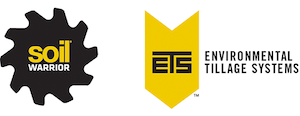[Podcast] Dairy Farmer Transforms Operation with Strip-Till
On this edition of the Strip-Till Farmer podcast, brought to you by Environmental Tillage Systems, we catch up with Hatley, Wis., strip-tiller Mike Fischer as he gets ready to make spring strips.
On this edition of the Strip-Till Farmer podcast, brought to you by Environmental Tillage Systems, we catch up with Hatley, Wis., strip-tiller Mike Fischer as he gets ready to make spring strips
Fischer details his entry point into strip-till, which included a lease-to-own program with an ETS SoilWarrior, and he also explains how the reduced tillage practice is increasing the efficiency of his manure management system.
Fischer dives into his crop rotation and usage of cover crops, reflects on the hurdles he overcame to make strip-till work on his farm, shares some words of advice for first-time strip-tillers and much more!
|
|
The Strip-Till Farmer podcast is brought to you by Environmental Tillage Systems.
SoilWarrior® systems help you defend your land and improve soil quality. With a choice of durable models, features and accessories, your SoilWarrior helps you minimize erosion while creating precise, nutrient-rich zones.
Let us help you defend your land and improve soil quality. Check out SoilWarrior systems online or request a demo today at www.soilwarrior.com.
Full Transcript
Noah Newman:Hey, great to have you with us for this edition of the Strip-Till Farmer Podcast brought to you by Environmental Tillage Systems. My name is Noah Newman. Today we're catching up with Hatley, Wisconsin strip-tiller Mike Fisher as he gets ready to make spring strips. Fisher details his entry point into strip-till, and also explains how the reduced tillage practice is really increasing the efficiency of his manure management system. Let's jump right in. Here's Mike.
Mike Fisher:We deal with a lot of cold weather, so central Wisconsin, Wasau area.
Noah Newman:You're a dairy operation, right? Tell us about that.
Mike Fisher:Yeah. We milk just over 1000 cows. I built the farm up from eight cows back in 1969. Just been growing ever since.
Noah Newman:Wow, that's a lot of growth. Give me an idea. You're a multi generation farmer, or how did you guys get started?
Mike Fisher:I grew up farming just north of here. When I was 16, my dad sold the farm. I was a farmer without a farm. So, I started all over with the help of my father-in-law, and my dad, too. Everybody gave me a lot of help and we got going.
Noah Newman:What's your crop rotation right now?
Mike Fisher:Corn, and alfalfa, and about 1800 acres of beans, [inaudible 00:01:29] polish beans, we started growing last year.
Noah Newman:I got you. So let's talk about strip-till. How long have you been strip-tilling for?
Mike Fisher:I think it's about eight years or so?
Noah Newman:About eight years. So decent amount of time. And what was your motivation for getting into strip-till?
Mike Fisher:Mainly to conserve the soil and to quit picking rocks. We get a lot of rocks.
Noah Newman:It's pretty challenging soils. And as you said, the climate is tough for you too. Does it help with that?
Mike Fisher:Oh, the climate is tool here. and it works after alfalfa, works quite well. But after corn, not so good.
Noah Newman:Now are you doing a corn soybean rotation or corn-corn? What's your rotation like on most beans?
Mike Fisher:Well it's mainly corn, alfalfa, grass inseed at the second year, [inaudible 00:02:23] and then we go back into corn again. But we do some acres under corn bean rotation also. Mainly for the outer acres that are harder to get to in the year.
Noah Newman:And are you only strip-tilling your corn acres or strip-tilling everything?
Mike Fisher:Everything. Everything except alfalfa.
Noah Newman:All right, so let's go back to your first year of strip-tilling. I know equipment can be expensive so how were you able to afford the equipment and what did you use? I know you used a SoilWarrior, right?
Mike Fisher:Correct. It's a battle between years. Because [inaudible 00:03:06] is a big season. The good news though is, in diary farming, just taking [inaudible 00:03:15] farming, but even more soy, is that you have good years and bad years. Some years cash flow has been a problem. Those are the years that we decided to take the jump and get into it because I could see the value there.
Noah Newman:Yeah. I was reading a little bit about your background. Was it a lease to own program that kind of helped you get the SoilWarrior?
Mike Fisher:Correct.
Noah Newman:Would you recommend if other first time strip-tillers look into something like that?
Mike Fisher:Absolutely. That's a unique program and it works. You got to get soil between years. You got to be a believer, and this gives the opportunity to prove it to yourself.
Noah Newman:And did you have a lot of friends or did you go to conferences? How did you kind of learn about strip-till?
Mike Fisher:Mostly online.
Noah Newman:Yeah you can pretty much learn anything online, if you go to YouTube or... Quick search on YouTube could turn into three hours before you know it.
All right, now let's jump into this aspect of your operations. What's it been like pairing a strip-till system with a livestock operation?
Mike Fisher:There's challenges there. That's also the biggest reason why most people won't take the jump.
Noah Newman:And so tell me a little bit about that. What makes it challenging with the manure?
Mike Fisher:Just the first thing you do every spring, [inaudible 00:04:33] not a good time to be driving across your fields because they're usually wet. And so we try to hold on as much as we can. I got somebody to do that. But that's only about half. The rest if it, the fields are just too small or too far away so we still have to [inaudible 00:04:52]. There's lots of different ways of getting it there, but compassion is always the battle.
Noah Newman:So are you making your strips in the fall or spring?
Mike Fisher:I just don't really like to make fall strips. I'm lucky to get the crop off, you know?
Noah Newman:Yeah. So here as we're doing this interview, it's late April. Have you made your strips yet for this spring? Or are you still waiting?
Mike Fisher:I'm still waiting. We're still battling the manure application, we'll do that for another week or two. But we'll start. Even though we hire a lot of the manure, we can start our cropping operation before we're done with manure. But we like to get a chunk of it done before we even start.
Noah Newman:Oh. So you're applying the manure before you strip-till. And you strip till through it?
Mike Fisher:Yeah. Yeah. That being said, I think that's probably a good solution. A lot of those challenges were there. [inaudible 00:05:47] fix the equipment before going to the [inaudible 00:05:53] all summer. [inaudible 00:05:56] grass into our hayfields, into our fossil fields, we're able to build up resilience. Take apache into the fields, [inaudible 00:06:12] obvious. Before we put [inaudible 00:06:14] on those fields and rotating back to corn. And then the [inaudible 00:06:19] over the summer toward the [inaudible 00:06:23] season.
Noah Newman:Oh, I see. So having the living roots in the ground help us compact them.
Mike Fisher:Yeah.
Noah Newman:I've heard that. So you're doing cereal rye or what?
Mike Fisher:Yeah. We do cereal rye, and actually all of our silage acres. We've done some interseeding, we've put together our own inter seeder and done some interseeding too. So that will be at [inaudible 00:06:50] time.
Noah Newman:So you do a little bit of interseeding around side dress time, and the rest of the cereal rye, how are you applying that? Are you doing that after harvest in the fall? Or?
Mike Fisher:We put an interseeder on our vertical till, we got a [inaudible 00:07:17] vertical till disk. So we interseed it as we [inaudible 00:07:17] acres is we get that done on time. We do some on the bean acres too, [inaudible 00:07:21].
Noah Newman:Oh, os you're doing some vertical tillage. Wow, that's funny you brought that up because we were talking about that the other day around the office. Vertical tillage is a tool to get those cover crops incorporated. Is that mainly what you use the vertical till for?
Mike Fisher:That and I get the field smooth, leveled off, in the fall to prepare it for alfalfa.
Noah Newman:You're doing the vertical till before harvest? Or after?
Mike Fisher:After.
Noah Newman:After. Okay. All right, going back to the manure management. How are you working the liquid manure in? And approximately about how much do you apply?
Mike Fisher:Since we started putting manure on during the growing season, we've reduced our rates. Right now they all go from four to eight ton to the acre, depending on the situation. [inaudible 00:08:14] what the crop is going to be. [inaudible 00:08:18] and flipping on during the summer. Spreads the season out [inaudible 00:08:26] alfalfa.
Noah Newman:What does the rest of your fertility plan look like? Does most of your fertility come from the manure or do you apply other elements with the strip till bar, or?
Mike Fisher:Yeah, definitely. We've got a two bin [inaudible 00:08:52] and so we'll take the [inaudible 00:08:58], mainly targeting the strip with that fertility. It really just helped our yields. I rented land so we're dealing with a variety of situations. [inaudible 00:09:19].
Noah Newman:And do you apply at variable rates or do you usually have a set rate every year?
Mike Fisher:Varied rate. Because I told you, [inaudible 00:09:28] plan for two and a half years, we test. So we lower the field needs and apply them [inaudible 00:09:37].
Noah Newman:All right, let's put a quick time out and here's a message about environmental tillage systems SoilWarriors. SoilWarrior systems help you defend your land and improve soil quality. With a choice of durable models, features and accessories, your SoilWarrior helps you minimize erosion while creating precise, nutrient rich zones. Let us help you defend your land and improve soil quality. Check out SoilWarrior Systems online or request a demo today at SoilWarrior.com. That's SoilWarrior.com. Now, back to the conversation.
What would you say is your approximate nitrogen rate per bushel raise? You know you hear some people aiming for around a pound of nitrogen per bushel. Are you around there?
Mike Fisher:I think we're around that. Our highest yield in till last year had low nitrogen, so I just said "Oh. There was just alfalfa and manure." You know? I mean, and the alfalfa rotation, and manure. And we put some nitrogen out with the strip till, wanting sulfate [inaudible 00:10:47] and ESN. [inaudible 00:10:50] bushels to the acre. It worked.
Noah Newman:Wow. Yeah, I've heard of other people being able to kind of back off on the nitrogen, especially with strip-till and still get pretty good results.
Mike Fisher:Especially after alfalfa. We get it at just twenty bushel, you'll [inaudible 00:11:10] after alfalfa.
Noah Newman:Interesting, interesting. So how would you say strip-till has made your life a little bit easier?
Mike Fisher:It made it all possible. We are growing during this period and count on this, This period from the time we first rented SoilWarrior. And so, some real challenges get the job done in a timely manner and we're able to do it only because of the SoilWarrior. When you grow that fast, it's a real challenge just getting it done.
Noah Newman:Yeah. So the time to get back on the clock with strip-till is the biggest benefit, you'd say?
Mike Fisher:Yeah. Especially with [inaudible 00:11:54] yieldage. For us, we have to get that done Memorial Day weekend. That's when it has to be done. We don't get fuller crops off of, or any crops of alfalfa any other way. And so we got to have a [inaudible 00:12:14] still going to till. Well, that's another thing, the resilience you get from SoilWarriors [inaudible 00:12:22].
Noah Newman:Yeah. I've heard it helps with erosion control. It's a resilient system, you hear a lot about.
Mike Fisher:Right. And to resist it to compassion. Not that we don't still have some compassion, it really does. But those are the biggest, biggest challenge and we're [inaudible 00:12:48]. So I thought that was cool.
Noah Newman:Oh. Interesting. What kind of spray are you getting?
Mike Fisher:Hagee. Hagee is supposed to help for that.
Noah Newman:And so you're going to use that to apply nitrogen in season?
Mike Fisher:Yeah. We're going to do eye drops. [inaudible 00:13:13] It ain't laid back or [inaudible 00:13:20]. Every day is a tight window. You have to make a thousand [inaudible 00:13:27] in three days. Some people can't comprehend that, but that's what you do.
Noah Newman:Yeah. What would you say are some of your biggest lessons with strip-till when you first started? Or was it just you got started and there weren't that many road bumps with it? What would you say?
Mike Fisher:Is learning how to use it and still maintain high yields and still maintain or improve fertility. Not just maintain it, improve it. For years it was a hassle. Every aspect of it is a tool for [inaudible 00:14:07] profitability.
Noah Newman:Now do you host a lot of field days?
Mike Fisher:I think we've done one but it wasn't with the SoilWarrior. It was more on the ancient hays.
Noah Newman:Well, it sounds like strip-till is working really well for you. Would you have any advice for people who are thinking about getting into strip-till? Or maybe some dairy farmers. Would you recommend strip-till for them?
Mike Fisher:Absolutely. Absolutely. Strip-tilling is a game changer. A real game changer to make our operation more resilient and more profitable.
Noah Newman:All right, now I wanted to just kind of hammer down your timeline for the year. So, I guess starting in the fall after harvest and going... Take me through step by step of when you're making strips, and then when you're planting, and then when you're working in the manure. Just so I have the timeline down of everything.
Mike Fisher:The first planting after hay, after alfalfa the first crop we have is [inaudible 00:15:15] and that's usually, when it's [inaudible 00:15:16], about ten days. Then we're going right into high moisture corn. [inaudible 00:15:25]. So very little time in between to do cover crops, but we squeeze it in somehow. [inaudible 00:15:36].
Noah Newman:Yeah.
Mike Fisher:And then it's manure now, after corn silage, we got to get manure going too. That kind of gets in the way.
Noah Newman:How deep do you apply the manure or are you spreading it? What's the process there?
Mike Fisher:Really to get it going in an effective manner we have to put it on top. Otherwise you can't do tillage. If you want to inject manure you can't do tillage.
Noah Newman:And so you have like a spreader that you own?
Mike Fisher:Yeah, we have a fertilizer spreader and for manure we have two, at least, spreaders that we use for sand. We use sand for beddings. That's another big compaction issue because that's really heavy. That's what we're doing right now. [inaudible 00:16:32] one of them is completely full of sand.
Noah Newman:And then what kind of planter do you have?
Mike Fisher:John Deere. High speed, twelve row.
Noah Newman:High speed twelve row? So do you have a lot of precision technology on it?
Mike Fisher:I have.
Noah Newman:Tell me about that. What are some of the bells and whistles on your planter?
Mike Fisher:Row [inaudible 00:16:58] downforce. I don't know, I don't do the planting so I'm not [inaudible 00:17:03] to tell you the truth. My son does that.
Noah Newman:Oh. I see. THat's nice you have some help from your son.
Mike Fisher:Absolutely necessary, believe me.
Noah Newman:Yeah. You wouldn't be able to do everything by yourself. I'm sure that'd be impossible.
Mike Fisher:We've been really good at bringing our Mexican help up and getting involved in the field operations, and shooting the cows. They've been a great help. Couldn't farm my [inaudible 00:17:39] without them.
Noah Newman:Now, does your son run the strip-till rig too?
Mike Fisher:No, usually [inaudible 00:17:44] me or a hired person does that. That's a field operation.
Noah Newman:Do you know how deep he makes the strips?
Mike Fisher:Yeah, they're like four to six inches. Somewhere in that realm.
Noah Newman:Four to six. Yeah, that seems to be a sweet spot for most people.
Mike Fisher:Yeah. And the SoilWarrior works too good at that. We have a lot of cobblestone and stuff, and the SoilWarrior holds up quite well. I'm excited.
Noah Newman:Is it a twelve row?
Mike Fisher:Yeah.
Noah Newman:I was going to ask you about the planter. Are you applying any starter fertilizer or anything with the planter?
Mike Fisher:Yes. Just a pop-up. Pop up nitrogen. I think it's like four gallons to the acre.
Noah Newman:Oh, I see.
Mike Fisher:Yeah.
Noah Newman:All right, well that's actually all the questions I had on my list here. Is there anything else you think I'm leaving out or anything else you want to add about your strip-till livestock system?
Mike Fisher:One of the things I think that a lot of dairy farmers have not adopted this system in our area at all hardly, the power of [inaudible 00:18:54]. They have to get over the hurdle of [inaudible 00:19:02] in the way of the good. [inaudible 00:19:05] that tillage can give you in the spring and you don't want to [inaudible 00:19:13] row compaction so you till away all the [inaudible 00:19:16]. And you're going to get some of that. But the benefits far outweigh that. And that's the main point I want to say. [inaudible 00:19:29].
Noah Newman:Yeah. Do you have a specific number or a percentage would you say? As to how much strip-till has increased your profitability?
Mike Fisher:No, I don't. It's hard to put a finger on it because there's so much that involves the timeliness of your planting and harvesting and all that. Like I said, when you're enlarging, doing dairy farm is just impossible to get done and roll without maybe hanging it out, and that wouldn't always work. Because you [inaudible 00:20:10]. So it's the only way to get it done effectively. It's worked for us. I can't tell you how much it's worked.
Noah Newman:All right, that'll wrap things up. Big thanks to Mike Fisher for taking the time to talk with us. Also, thanks to our sponsor, Environmental Tillage Systems for making this podcast series possible. Until next time, for all things strip-till, head to StripTillFarmer.com. Thanks for tuning in. Have a great day.







